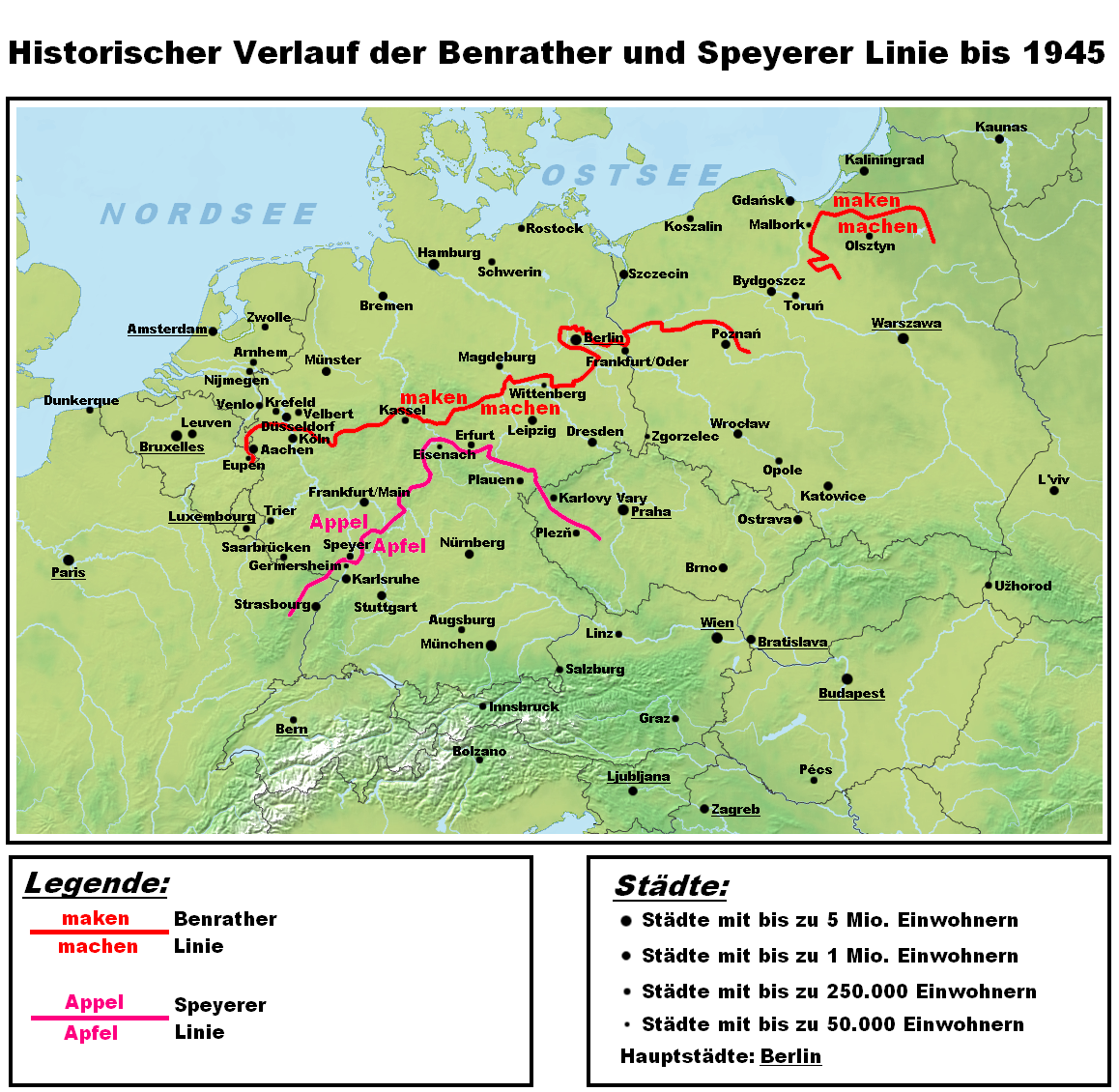Speyer line on:
[Wikipedia]
[Google]
[Amazon]
 In German dialectology, the Speyer line or Main line ( Main River) is an
In German dialectology, the Speyer line or Main line ( Main River) is an
 In German dialectology, the Speyer line or Main line ( Main River) is an
In German dialectology, the Speyer line or Main line ( Main River) is an isogloss
An isogloss, also called a heterogloss, is the geographic boundary of a certain linguistics, linguistic feature, such as the pronunciation of a vowel, the meaning of a word, or the use of some morphological or syntactic feature. Isoglosses are a ...
separating the Central German
Central German or Middle German () is a group of High German languages spoken from the Rhineland in the west to the former eastern territories of Germany.
Central German divides into two subgroups, West Central German and East Central Ger ...
dialect
A dialect is a Variety (linguistics), variety of language spoken by a particular group of people. This may include dominant and standard language, standardized varieties as well as Vernacular language, vernacular, unwritten, or non-standardize ...
s to the north, which have a stop in words like ''Appel'' "apple", from the Upper German
Upper German ( ) is a family of High German dialects spoken primarily in the southern German-speaking area ().
History
In the Old High German time, only Alemannic and Bairisch are grouped as Upper German. In the Middle High German time, East F ...
dialects to the south, which have an affricate
An affricate is a consonant that begins as a stop and releases as a fricative, generally with the same place of articulation (most often coronal). It is often difficult to decide if a stop and fricative form a single phoneme or a consonant pai ...
, ''Apfel''.
The Speyer line begins in Alsace
Alsace (, ; ) is a cultural region and a territorial collectivity in the Grand Est administrative region of northeastern France, on the west bank of the upper Rhine, next to Germany and Switzerland. In January 2021, it had a population of 1,9 ...
near Strasbourg
Strasbourg ( , ; ; ) is the Prefectures in France, prefecture and largest city of the Grand Est Regions of France, region of Geography of France, eastern France, in the historic region of Alsace. It is the prefecture of the Bas-Rhin Departmen ...
, and runs northeast to Thüringen, crossing the Rhine
The Rhine ( ) is one of the List of rivers of Europe, major rivers in Europe. The river begins in the Swiss canton of Graubünden in the southeastern Swiss Alps. It forms part of the Swiss-Liechtenstein border, then part of the Austria–Swit ...
at Speyer
Speyer (, older spelling ; ; ), historically known in English as Spires, is a city in Rhineland-Palatinate in the western part of the Germany, Federal Republic of Germany with approximately 50,000 inhabitants. Located on the left bank of the r ...
. After passing close to Erfurt
Erfurt () is the capital (political), capital and largest city of the Central Germany (cultural area), Central German state of Thuringia, with a population of around 216,000. It lies in the wide valley of the Gera (river), River Gera, in the so ...
, it turns southeast and continues into the formerly German
German(s) may refer to:
* Germany, the country of the Germans and German things
**Germania (Roman era)
* Germans, citizens of Germany, people of German ancestry, or native speakers of the German language
** For citizenship in Germany, see also Ge ...
-speaking parts of Bohemia
Bohemia ( ; ; ) is the westernmost and largest historical region of the Czech Republic. In a narrow, geographic sense, it roughly encompasses the territories of present-day Czechia that fall within the Elbe River's drainage basin, but historic ...
. The line is exemplified by place names containing an uncombined /p/ phoneme, which are located north of the line and include Paderborn
Paderborn (; Westphalian language, Westphalian: ''Patterbuorn'', also ''Paterboärn'') is a city in eastern North Rhine-Westphalia, Germany, capital of the Paderborn (district), Paderborn district. The name of the city derives from the river Pade ...
, Potsdam
Potsdam () is the capital and largest city of the Germany, German States of Germany, state of Brandenburg. It is part of the Berlin/Brandenburg Metropolitan Region. Potsdam sits on the Havel, River Havel, a tributary of the Elbe, downstream of B ...
, and Wuppertal
Wuppertal (; ) is a city in North Rhine-Westphalia, in western Germany, with a population of 355,000. Wuppertal is the seventh-largest city in North Rhine-Westphalia and List of cities in Germany by population, 17th-largest in Germany. It ...
. Those with an affricate /pf/, including Pfaffenhofen and Pforzheim
Pforzheim () is a List of cities and towns in Germany, city of over 125,000 inhabitants in the federal state of Baden-Württemberg, in the southwest of Germany.
It is known for its jewelry and watch-making industry, and as such has gained the ...
, lie mostly to the south.
See also
*Benrath line
In German linguistics, the Benrath line () is the isogloss: dialects north of the line have the original in (to make), while those to the south have the innovative (). The line runs from Aachen in the west via Benrath (south of Düsseldorf) ...
* High German consonant shift
In historical linguistics, the High German consonant shift or second Germanic consonant shift is a phonological development (sound change) that took place in the southern parts of the West Germanic languages, West Germanic dialect continuum. The ...
* Sankt Goar line
* Uerdingen line
The Uerdingen Line (, ; named after Uerdingen by Georg Wenker) is the isogloss within West Germanic languages that separates dialects which preserve the ''-k'' sound in the first person singular pronoun word "ik" (north of the line) from dialec ...
References
German language Isoglosses {{Germanic-lang-stub